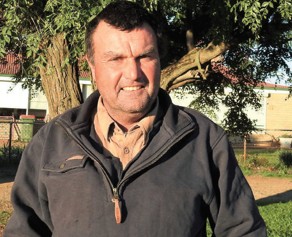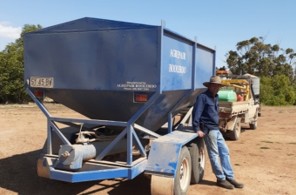Name:
Lachlan Smart
Location:
Wirrabara
Average Rainfall:
480 mm
Enterprises:
Wool, lambs, cropping
Farm Area:
1,600 ha
Lachlan Smart’s 1,600 hectare Avonmore property is located near Wirrabara. A key feature of the property is the 1,000 hectares of un-arable hill grazing country. A self-replacing merino flock of 1700 ewes are run, with 1200 ewes mated to merinos and 500 merino ewes mated to produce crossbred lambs. Five hundred merino ewe hoggets are retained annually as replacement ewes. With the dry springs and reduced pasture growth over the last few seasons numbers have been reduced.
Four hundred hectares of the 600 hectares of arable land is sown with crops using No Till, stubble retention techniques. Sheep are lightly grazed on stubbles following harvest.
The remaining 200 ha of arable land is sown to vetch and oats for grazing. Average arable paddock size is around 40 ha, and temporary electric fencing is used to divide these paddocks into 15 ha grazing areas, to allow strip grazing at 100 DSE/ha during the winter and spring period. He normally targets to sell lambs at 23 to 25 kg dressed weight at the best market price, before Christmas to maximise the amount of quality dry feed available for the ewes In seasons with a dry spring, Lachy sells his merino lambs “unfinished” as in his situation he feels this is more profitable than handfeeding them to market weight. Crossbred lambs are all sold at target market weights.
With careful planning and management Lachlan (Lachy) Smart has been successfully lambing his 1,700 ewes in containment areas since 2013.
To manage the autumn feed gap, Lachy places all of his pregnant ewes (in mobs of 300 to 400 ewes) into containment areas ranging from 4 to 12 hectares in size. At this stocking density the area does not get muddy and the wool is kept clean. Generally this is done at the end of March (7 to 12 weeks before lambing), although it may be earlier after a poor season when there is less cover on stubble and pasture paddocks. He has found that 5 hectare areas are the ideal, allowing ewes some privacy from the rest of the mob when lambing, while ensuring they do not have to walk far for feed and water, thereby reducing their energy requirements. He tries to ensure that these paddocks have good ground cover when sheep first enter. Following opening rains, although there may be a germination of pasture, the ground cover on these areas are sacrificed to protect cover on the rest of the farm.
Lachy made the decision to lamb in containment areas to allow the unarable native pastures to get established and recover from spring and summer grazing. He has found unexpected benefits with less mis-mothering of lambs, because the ewes are content with adequate feed available. He started feeding every two days but has found that by feeding every day the ewes are much calmer and do not rush in when being fed, but rather come in slowly, especially ewes with new born lambs.
 Lachlan Smart
Lachlan SmartHay and grain are tested for feed quality to prepare feed rations that assist with optimising livestock production and profitability. By knowing the feed value, particularly energy content of grain and hay, Lachy says that he has been able to reduce the grain ration fed by up to three hundred grams per “dry sheep equivalent” per day. Livestock specialist Daniel Schuppan assists Lachy with preparing property feed budgets and grazing plans.
A one hundred and ten percent lambing rate is achieved by lambing ewes in these conditions. A two bin feed cart with weigh scales is used to accurately feed grain rations. Hay is fed separately at the rate of one kilogram per head per day.
Ewes and lambs are kept in the containment areas until there is adequate pasture growth and ground cover in pasture paddocks. This is usually around mid-winter.
A range of techniques are used to ensure livestock have access to water when grazing the temporary 15 hectare areas. These include a horse shoe configuration providing access to dams, water yards and only grazing certain areas during wet periods. Lachy says when small dams are dry on the Avonmore property this is often an indicator livestock shouldn’t be grazing those areas.

In conjunction with the containment areas the hills country is an integral part of a successful system. The hills country is mainly grazed in winter and early spring. With only brief periods of light grazing during the summer / autumn and late spring period to maximise seed set and optimise plant cover.
Lachy began rotational grazing in 2004 on part of the property, with the aim to improve pasture production, financial viability and ground cover. Livestock numbers were initially reduced on the hill country to allow increased seeding and establishment of perennials.
The hill country responded quickly to the change in grazing management, with increased growth and denser stands of perennial grasses in the first two years. Lachy has observed a reduction in Cape weed, stemless horse thistle and Salvation Jane density and growth, due to the increased ground cover and greater competition from native perennial grasses. This was achieved by managing livestock numbers and grazing intervals.
By delaying the grazing of the native grass pastures, annual grasses establish out competing less palatable broadleaf weeds, ensuring greater pasture diversity.
Timely removal of livestock has a significant impact on grass set seed and is likely to impact future pasture composition and productivity.
Case Study - Succesful Lambing in Containment Areas
This case study was written by Michael Wurst. Thanks to Lachlan Smart for providing the detail.